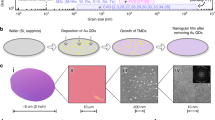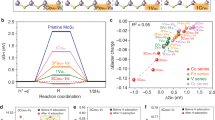Abstract
Our extensive first-principles calculations reveal that the chemical activities of monolayer transition metal dichalcogenides (TMDs) MX2 (M = Mo or W, and X = Te, Se, or S) for water splitting and hydrogen evolution are modified and promoted on their grain boundaries (GBs) when in-plane tensile loadings are applied. Compared with monolayer TMDs without GBs, the flexoelectricity induced by nonuniform deformation and strain gradient significantly enhances the charge polarizations of X and M atoms at the GB sites of monolayer TMDs, which facilitates the dissociation of water molecules on the GB sites and reduces the reaction barrier of hydrogen evolution reaction. The energy barriers of splitting water molecules and hydrogen adsorption free energies on the GB sites decrease with increasing the flexoelectric effect. These results highlight an attractive way of utilizing the flexoelectric effect of GB-containing TMDs to improve their surface catalytic capability for hydrogen generation.

Similar content being viewed by others
References
Dresselhaus, M. S.; Thomas, I. L. Alternative energy technologies. Nature 2001, 414, 332–337.
Turner, J. A. Sustainable hydrogen production. Science 2004, 305, 972–974.
Paracchino, A.; Laporte, V.; Sivula, K.; Grätzel, M.; Thimsen, E. Highly active oxide photocathode for photoelectrochemical water reduction. Nat. Mater. 2011, 10, 456–461.
Ursúa, A.; Gandía, L.M.; Sanchis, P. Hydrogen production from water electrolysis: Current status and future trends. Proc. IEEE 2012, 100, 410–426.
Walter, M. G.; Warren, E. L.; McKone, J. R.; Boettcher, S. W.; Mi, Q. X.; Santori, E. A.; Lewis, N. S. Solar water splitting cells. Chem. Rev. 2010, 110, 6446–6473.
Tiwari, A. P.; Azam, A.; Novak, T. G.; Prakash, O.; Jeon, S. Chemical strain formation through anion substitution in Cu2WS4 for efficient electrocatalysis of water dissociation. J. Mater. Chem. A 2018, 6, 7786–7793.
Sirkin, Y. A. P.; Hassanali, A.; Scherlis, D. A. One-dimensional confinement inhibits water dissociation in carbon nanotubes. J. Phys. Chem. Lett. 2018, 9, 5029–5033.
Hisatomi, T.; Kubota, J.; Domen, K. Recent advances in semiconductors for photocatalytic and photoelectrochemical water splitting. Chem. Soc. Rev. 2014, 43, 7520–7535.
Maeda, K.; Domen, K. Photocatalytic water splitting: Recent progress and future challenges. J. Phys. Chem. Lett. 2010, 1, 2655–2661.
Moniz, S. J. A.; Shevlin, S. A.; Martin, D. J.; Guo, Z. X.; Tang, J. W. Visible-light driven heterojunction photocatalysts for water splitting — a critical review. Energy Environ. Sci. 2015, 8, 731–759.
Seh, Z. W.; Kibsgaard, J.; Dickens, C. F.; Chorkendorff, I.; Nørskov, J. K.; Jaramillo, T. F. Combining theory and experiment in electrocatalysis: Insights into materials design. Science 2017, 355, eaad4998.
Greeley, J.; Jaramillo, T. F.; Bonde, J.; Chorkendorff, I. B.; Nørskov, J. K. Computational high-throughput screening of electrocatalytic materials for hydrogen evolution. Nat. Mater. 2006, 5, 909–913.
Akinwande, D.; Brennan, C. J.; Bunch, J. S.; Egberts, P.; Felts, J. R.; Gao, H. J.; Huang, R.; Kim, J. S.; Li, T.; Li, Y. et al. A review on mechanics and mechanical properties of 2D materials—Graphene and beyond. Ext. Mech. Lett. 2017, 13, 42–77.
Jariwala, D.; Sangwan, V. K.; Lauhon, L. J.; Marks, T. J.; Hersam, M. C. Emerging device applications for semiconducting two-dimensional transition metal dichalcogenides. ACS Nano 2014, 8, 1102–1120.
Lopez-Sanchez, O.; Lembke, D.; Kayci, M.; Radenovic, A.; Kis, A. Ultrasensitive photodetectors based on monolayer MoS2. Nat. Nanotechnol. 2013, 8, 497–501.
Jin, H. Y.; Guo, C. X.; Liu, X.; Liu, J. L.; Vasileff, A.; Jiao, Y.; Zheng, Y.; Qiao, S. Z. Emerging two-dimensional nanomaterials for electrocatalysis. Chem. Rev. 2018, 118, 6337–6408.
Dang, K. Q.; Spearot, D. E. Effect of point and grain boundary defects on the mechanical behavior of monolayer MoS2 under tension via atomistic simulations. J. Appl. Phys. 2014, 116, 013508.
Wei, Y. J.; Wu, J. T.; Yin, H. Q.; Shi, X. H.; Yang, R. G.; Dresselhaus, M. The Nature of strength enhancement and weakening by pentagonheptagon defects in graphene. Nat. Mater. 2012, 11, 759–763.
Zou, X. L.; Liu, Y. Y.; Yakobson, B. I. Predicting dislocations and grain boundaries in two-dimensional metal-disulfides from the first principles. Nano Lett. 2013, 13, 253–258.
Wang, S. S.; Sawada, H.; Han, X. Y.; Zhou, S.; Li, S.; Guo, Z. X.; Kirkland, A. I.; Warner, J. H. Preferential Pt nanocluster seeding at grain boundary dislocations in polycrystalline monolayer MoS2. ACS Nano 2018, 12, 5626–5636.
Zhang, Z. H.; Zou, X. L.; Crespi, V. H.; Yakobson, B. I. Intrinsic magnetism of grain boundaries in two-dimensional metal dichalcogenides. ACS Nano 2013, 7, 10475–10481.
Xie, J. F.; Qu, H. C.; Xin, J. P.; Zhang, X. X.; Cui, G. W.; Zhang, X. D.; Bao, J.; Tang, B.; Xie, Y. Defect-rich MoS2 nanowall catalyst for efficient hydrogen evolution reaction. Nano Res. 2017, 10, 1178–1188.
Lin, J. H.; Wang, P. C.; Wang, H. H.; Li, C.; Si, X. Q.; Qi, J. L.; Cao, J.; Zhong, Z. X.; Fei, W. D.; Feng, J. C. Defect-rich heterogeneous MoS2/NiS2 nanosheets electrocatalysts for efficient overall water splitting. Adv. Sci. 2019, 6, 1900246.
Han, W. Q.; Liu, Z. H.; Pan, Y. B.; Guo, G. N.; Zou, J. X.; Xia, Y.; Peng, Z. M.; Li, W.; Dong, A. G. Designing champion nanostructures of tungsten dichalcogenides for electrocatalytic hydrogen evolution. Adv. Mater. 2020, 32, 2002584.
Kostov, M. K.; Santiso, E. E.; George, A. M.; Gubbins, K. E.; Nardelli, M. B. Dissociation of water on defective carbon substrates. Phys. Rev. Lett. 2005, 95, 136105.
Miao, M.; Shi, H.; Wang, Q.; Liu, Y. C. The Ti4 cluster activates water dissociation on defective graphene. Phys. Chem. Chem. Phys. 2014, 16, 5634–5639.
Li, H.; Tsai, C.; Koh, A. L.; Cai, L. L.; Contryman, A. W.; Fragapane, A. H.; Zhao, J. H.; Han, H. S.; Manoharan, H. C.; Abild-Pedersen, F. et al. Activating and optimizing MoS2 basal planes for hydrogen evolution through the formation of strained sulphur vacancies. Nat. Mater. 2016, 15, 48–53.
Conley, H. J.; Wang, B.; Ziegler, J. I.; Haglund, R. F. Jr.; Pantelides, S. T.; Bolotin, K. I. Bandgap engineering of strained monolayer and bilayer MoS2. Nano Lett. 2013, 13, 3626–3630.
Desai, S. B.; Seol, G.; Kang, J. S.; Fang, H.; Battaglia, C.; Kapadia, R.; Ager, J. W.; Guo, J.; Javey, A. Strain-induced indirect to direct bandgap transition in multilayer WSe2. Nano Lett. 2014, 14, 4592–4597.
Wu, W. Z.; Wang, L.; Li, Y. L.; Zhang, F.; Lin, L.; Niu, S. M.; Chenet, D.; Zhang, X.; Hao, Y. F.; Heinz, T. F. et al. Piezoelectricity of single-atomic-layer MoS2 for energy conversion and piezotronics. Nature 2014, 514, 470–474.
Zhu, H. Y.; Wang, Y.; Xiao, J.; Liu, M.; Xiong, S. M.; Wong, Z. J.; Ye, Z. L.; Ye, Y.; Yin, X. B.; Zhang, X. Observation of piezoelectricity in free-standing monolayer MoS2. Nat. Nanotechnol. 2015, 10, 151–155.
Shi, W. H.; Guo, Y. F.; Zhang, Z. H.; Guo, W. L. Flexoelectricity in monolayer transition metal dichalcogenides. J. Phys. Chem. Lett. 2018, 9, 6841–6846.
Zhou, W.; Zou, X. L.; Najmaei, S.; Liu, Z.; Shi, Y. M.; Kong, J.; Lou, J.; Ajayan, P. M.; Yakobson, B. I.; Idrobo, J. C. Intrinsic structural defects in monolayer molybdenum disulfide. Nano Lett. 2013, 13, 2615–2622.
Najmaei, S.; Liu, Z.; Zhou, W.; Zou, X. L.; Shi, G.; Lei, S. D.; Yakobson, B. I.; Idrobo, J. C.; Ajayan, P. M.; Lou, J. Vapour phase growth and grain boundary structure of molybdenum disulphide atomic layers. Nat. Mater. 2013, 12, 754–759.
Kresse, G.; Furthmüller, J. Efficient iterative schemes for ab initio total-energy calculations using a plane-wave basis set. Phys. Rev. B 1996, 54, 11169–11186.
Blöchl, P. E. Projector augmented-wave method. Phys. Rev. B 1994, 50, 17953–17979.
Perdew, J. P.; Burke, K.; Ernzerhof, M. Generalized gradient approximation made simple. Phys. Rev. Lett. 1996, 77, 3865–3868.
Dion, M.; Rydberg, H.; Schröder, E.; Langreth, D. C.; Lundqvist, B. I. Van der Waals density functional for general geometries. Phys. Rev. Lett. 2004, 92, 246401.
Henkelman, G.; Uberuaga, B. P.; Jónsson, H. A climbing image nudged elastic band method for finding saddle points and minimum energy paths. J. Chem. Phys. 2000, 113, 9901–9904.
Henkelman, G.; Jónsson, H. Improved tangent estimate in the nudged elastic band method for finding minimum energy paths and saddle points. J. Chem. Phys. 2000, 113, 9978–9985.
Seo, B.; Jung, G.; Sa, Y. J.; Jeong, H. Y.; Cheon, J. Y.; Lee, J. H.; Kim, H. Y.; Kim, J. C.; Shin, H. S.; Kwak, S. K. et al. Monolayerprecision synthesis of molybdenum sulfide nanoparticles and their nanoscale size effects in the hydrogen evolution reaction. ACS Nano 2015, 9, 3728–3739.
Pandey, M.; Vojvodic, A.; Thygesen, K. S.; Jacobsen, K. W. Two-dimensional metal dichalcogenides and oxides for hydrogen evolution: A computational screening approach. J. Phys. Chem. Lett. 2015, 6, 1577–1585.
Tang, W.; Sanville, E.; Henkelman, G. A grid-based Bader analysis algorithm without lattice bias. J. Phys. Condens. Matter 2009, 21, 084204.
Sanville, E.; Kenny, S. D.; Smith, R.; Henkelman, G. Improved grid-based algorithm for Bader charge allocation. J. Comput. Chem. 2007, 28, 899–908.
Henkelman, G.; Arnaldsson, A.; Jónsson, H. A fast and robust algorithm for Bader decomposition of charge density. Comput. Mater. Sci. 2006, 36, 354–360.
Yu, M.; Trinkle, D. R. Accurate and efficient algorithm for Bader charge integration. J. Chem. Phys. 2011, 134, 064111.
Acknowledgements
This work is supported by the National Natural Science Foundation of China (Nos. 11972186, 11890674, and 51921003), the Fundamental Research Funds for the Central Universities (No. NE2019001) of China, and a Project Funded by the Priority Academic Program Development of Jiangsu Higher Education Institutions.
Author information
Authors and Affiliations
Corresponding authors
Rights and permissions
About this article
Cite this article
Pu, M., Wang, D., Zhang, Z. et al. Flexoelectricity enhanced water splitting and hydrogen evolution reaction on grain boundaries of monolayer transition metal dichalcogenides. Nano Res. 15, 978–984 (2022). https://doi.org/10.1007/s12274-021-3584-8
Received:
Revised:
Accepted:
Published:
Issue Date:
DOI: https://doi.org/10.1007/s12274-021-3584-8




